- Smallsword issued by the French Crown, 1789
- Sabre of Honour offered to Vauban by the Rebels during the American War of Independence

Weapons of Honour (French: Armes d'honneur) are ceremonial weapons awarded for service or assistance to France.

Weapons of Honour (French: Armes d'honneur) are ceremonial weapons awarded for service or assistance to France.
Swords of honour were awarded during the Ancien Régime for exceptional service. On 30 April 1746, Minister of the Navy Maurepas awarded such a sword to privateer Pierre Anguier for his intervention in the Jacobite rising of 1745. [1]
Established on 25 December 1799 and issued by the French Consulate, weapons of honour were awarded as military awards for feats of arms. The civilian version of this distinction is the scarf of honour (l'écharpe d'honneur). This completed and materialised the practice of solemnly declaring a citizen or group of citizens to have bien mérité de la Patrie.
Weapons of honour were replaced during the First French Empire by the institution of the chivalry Order of the Legion of Honour. Recipients of weapons of honour automatically received the Legion of Honour after its inception.
Each component of the Napoleonic armies had its own distinction and weapons of honour:
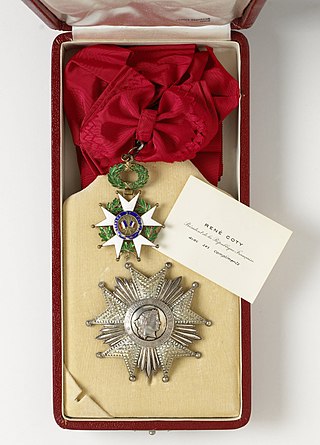
The National Order of the Legion of Honour, formerly the Imperial Order of the Legion of Honour, is the highest French order of merit, both military and civil, and currently comprises five classes. Established in 1802 by Napoleon Bonaparte, it has been retained by all later French governments and regimes.
The Grande Armée was the main military component of the French Imperial Army commanded by Emperor Napoleon Bonaparte during the Napoleonic Wars. From 1804 to 1808, it won a series of military victories that allowed the French Empire to exercise unprecedented control over most of Europe. Widely acknowledged to be one of the greatest fighting forces ever assembled, it suffered catastophic losses during the disastrous Peninsular War followed by the invasion of Russia in 1812, after which it never recovered its strategic superiority and ended in total defeat for Napoleonic France by the Peace of Paris in 1815.
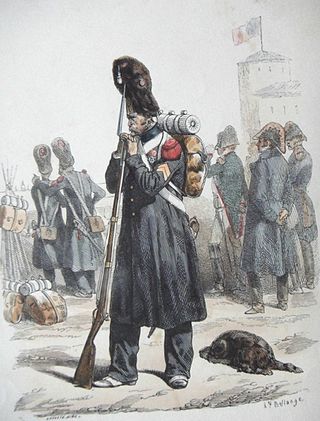
The Imperial Guard was an elite guard formation of the French Imperial Army under the direct command of Napoleon. Expanding considerably over time, the formation acted as his bodyguard and tactical reserve, and he was careful of its use in battle. The Imperial Guard was divided into a general staff and infantry, cavalry and artillery regiments as well as battalions of sappers and marines. It distinguished between experienced veterans and less experienced members by being separated into three sections: the Old Guard, Middle Guard and Young Guard. The Young Guard was virtually annihilated in the Battle of Krasnoi during the French invasion of Russia.
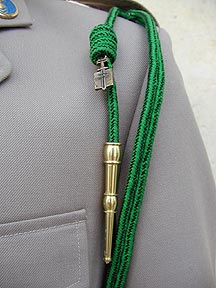
The Order of Liberation is a French Order which was awarded to heroes of the Liberation of France during World War II. It is a very high honour, second only after the Légion d’Honneur. Very few people, military units and communes were ever awarded it; and only for their deeds during World War II. A different order, the Médaille de la Résistance, was created and awarded for lesser but still distinguished deeds by members of the Resistance.

Rank insignia in the French Army are worn on the sleeve or on shoulder marks of uniforms, and range up to the highest rank of Marshal of France, a state honour denoted with a seven-star insignia that was last conferred posthumously on Marie Pierre Koenig in 1984.

The Musée de l'Armée is a national military museum of France located at Les Invalides in the 7th arrondissement of Paris. It is served by Paris Métro stations Invalides, Varenne and La Tour-Maubourg
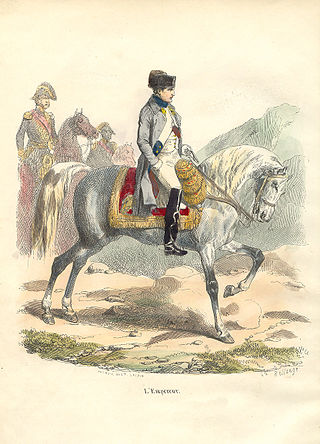
The uniforms of La Grande Armée, the army of Napoleon I, are described in this article.

The Army of the Alps was one of the French Revolutionary armies. It existed from 1792–1797 and from July to August 1799, and the name was also used on and off until 1939 for France's army on its border with Italy.
Général Baron Claude Testot-Ferry was a cavalry veteran of the armies of the First French Republic, First French Empire and Bourbon Restoration.

The Éclaireurs of the Guard was a Corps of cavalry scouts of the French Imperial Guard, which included three cavalry regiments created by Napoleon when he reorganised the Imperial Guard following the disaster of the French invasion of Russia. The Corps was created in Article I of the decree of 4 December 1813.
Capitaine Gustave Victorin Daladier was a French World War I flying ace credited with twelve aerial victories. He would continue in his nation's military service after World War I.
Sous Lieutenant Fernand Eugene Guyou was a World War I flying ace credited with twelve aerial victories.

Marie-Thérèse Figueur, known by the nom de guerreSans-Gêne, was a French soldier who fought in the French Revolutionary Wars and Napoleonic Wars. Unlike some other female soldiers before the twentieth century, she did not disguise her gender when she enlisted, serving for twenty-two years under her own name in the French Revolutionary Army and the Grande Armée.

Bien mérité de la Patrie is a French expression that qualifies national heroes. During the French Revolution, the phrase became a formula discerned as an award by the National Convention to deserving citizens.

Auguste-Frédéric de Talhouët-Bonamour, marquis de Talhouët was a French general of the Napoleonic Wars. He was awarded the Military Merit Order along with several French orders.

Paul Gardy was Général de brigade of the French Army and Commandant of the Foreign Legion in 1951 and 1958.
Jean-Claude Coullon was a Général d'armée of the French Army and Commandant of the French Foreign Legion.

Pierre Henry Prosper Baccuet was a French military officer and landscape painter; known primarily for his Orientalist scenes.
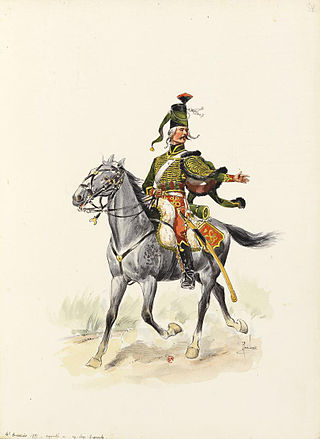
The Légion de Conflans later the Régiment de Saxe Hussards was a German-French legion formed during the War of the Austrian Succession. The legion would later serve in the Seven Years' War, but like the other French legions, legion was split and became a hussar regiment. However, following the beginning of the French Revolution, the regiment emigrated en masse and was disbanded shortly thereafter.

François Léon Jouinot-Gambetta was a French army officer. He joined the army as a cavalry trooper in 1888 and was commissioned in 1893. Jouinot-Gambetta initially specialised in geographical surveying and was deployed across French African territories. He was wounded in 1900 during a mission in Mauritania. In the first years of the 20th century Jouinot-Gambetta served with the Ministry of Foreign Affairs and the War Ministry. During the First World War he commanded a cavalry brigade on the Macedonian front and was responsible for a rapid advance that captured Skopje from the Bulgarians.